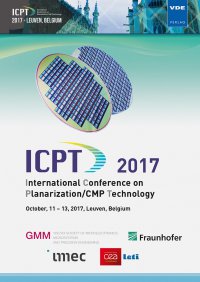Evaluation of Polyurethane Pads Properties for Effective Use in Planarization Process
Konferenz: ICPT 2017 - International Conference on Planarization/CMP Technology
11.10.2017 - 13.10.2017 in Leuven, Belgium
Tagungsband: ICPT 2017
Seiten: 3Sprache: EnglischTyp: PDF
Persönliche VDE-Mitglieder erhalten auf diesen Artikel 10% Rabatt
Autoren:
Chung, Hyunjae; Shin, Cheolmin (School of Mechanical Engineering, Sungkyunkwan University, 300 Chunchun-Dong, Jangan-Gu, Suwon, Kyunggi-Do, 440-746, South Korea)
Jin, Yinhua; Kim, Taesung (School of Mechanical Engineering, Sungkyunkwan University, 300 Chunchun-Dong, Jangan-Gu, Suwon, Kyunggi-Do, 440-746, South Korea & Advanced Institute of Nanotechnology (SAINT), Sungkyunkwan University, 300 Chunchun-Dong, Jangan-Gu, Suwon, Kyunggi-Do, 440-746, South Korea)
Inhalt:
In general, hydrogen peroxide (H2O2) have been utilized in CMP, which may cause adverse effects on the CMP pad. In the present work, the CMP pads were evaluated for change in property upon interaction with H2O2. For this, the CMP pads were soaked in H2O2 at 80 °C for 9 hours and its hardness, and a stress-strain properties were evaluated. Further, polyurethane polymer chain scission were evaluated by FT-IR. Subsequently, polishing performance was confirmed by polishing the SiO2 wafer with H2O2 soaked CMP pads. It is observed that, soaked CMP pads have less hardness as compared with the un-soaked pads and is time dependent. The hardness causes a change in compressibility and tends to increase strain under the same stress condition. The polyurethane structure and the polymer chain scission caused by the interaction with H2O2. Further in-depth evaluation is in process.


